Effect of Temperature on the Tear Fracture and Fatigue Life of Carbon-Black-Filled Rubber
Abstract
:1. Introduction
2. Materials and Testing
2.1. Basic Mechanical Behaviour
2.2. Tear Fracture Tests
2.3. Fatigue Crack Growth Tests (23 °C)
3. Test Results and Discussion
3.1. Temperature Dependence of Critical Tear Energy
3.2. Fatigue Crack Growth at 23 °C
4. High-Temperature Fatigue Life Prediction
5. Conclusions
Author Contributions
Funding
Conflicts of Interest
References
- Fang, Y.; Long, L.; Niu, S.; Yang, P.K.; Wang, Z.; Chen, J.; Zhou, Y.; Zi, Y.; Jie, W.; Liao, Q. Stretchable-rubber-based triboelectric nanogenerator and its application as self-powered body motion sensors. Adv. Funct. Mater. 2015, 25, 3688–3696. [Google Scholar]
- Yang, X.; Tu, Q.; Shen, X.; Zhu, P.; Li, Y.; Zhang, S. A novel method for deposition of multi-walled carbon nanotubes onto poly(p-phenylene terephthalamide) fibers to enhance interfacial adhesion with rubber matrix. Polymers 2019, 11, 374. [Google Scholar] [CrossRef] [PubMed]
- Chen, X.; An, J.; Cai, G.; Zhang, J.; Chen, W.; Dong, X.; Zhu, L.; Tang, B.; Wang, J.; Wang, X. Environmentally friendly flexible strain sensor from waste cotton fabrics and natural rubber latex. Polymers 2019, 11, 404. [Google Scholar] [CrossRef] [PubMed]
- Mars, W.V.; Fatemi, A. A literature survey on fatigue analysis approaches for rubber. Int. J. Fatigue 2002, 24, 949–961. [Google Scholar] [CrossRef]
- Mars, W.V. Factors that affect the fatigue life of rubber: A literature survey. Rubber Chem. Technol. 2004, 77, 391–412. [Google Scholar] [CrossRef]
- Tee, Y.L.; Loo, M.S.; Andriyana, A. Recent advances on fatigue of rubber after the literature survey by mars and fatemi in 2002 and 2004. Int. J. Fatigue 2018, 110, 115–129. [Google Scholar] [CrossRef]
- Carleo, F.; Barbieri, E.; Whear, R.; Busfield, J.J.C. Limitations of viscoelastic constitutive models for carbon-black reinforced rubber in medium dynamic strains and medium strain rates. Polymers 2018, 10, 988. [Google Scholar] [CrossRef] [PubMed]
- Marco, Y.; Huneau, B.; Masquelier, I.; Saux, V.L.; Charrier, P. Prediction of fatigue properties of natural rubber based on the descriptions of the cracks population and of the dissipated energy. Polym. Test. 2017, 59, 67–74. [Google Scholar] [CrossRef] [Green Version]
- Seichter, S.; Archodoulaki, V.M.; Koch, T.; Holzner, A.; Wondracek, A. Investigation of different influences on the fatigue behaviour of industrial rubbers. Polym. Test. 2017, 59, 99–106. [Google Scholar] [CrossRef]
- Ruellan, B.; Le Cam, J.B.; Jeanneau, I.; Canévet, F.; Mortier, F.; Robin, E. Fatigue of natural rubber under different temperatures. Int. J. Fatigue 2018. [Google Scholar] [CrossRef]
- Lake, G.J.; Lindley, P.B. Cut growth and fatigue of rubbers. II. Experiments on a noncrystallizing rubber. J. Appl. Polym. Sci. 1964, 8, 707–721. [Google Scholar] [CrossRef]
- Wu, J.; Chen, L.; Li, H.H.; Su, B.L.; Wang, Y.S. Effect of Temperature on Tensile Fatigue Life of Natural Rubber; IOP Conference Series; IOP Publishing: Bristol, UK, 2018; p. 012024. [Google Scholar]
- Thomas, A.G. The development of fracture mechanics for elastomers. Rubber Chem. Technol. 1994, 67, 50–67. [Google Scholar] [CrossRef]
- Lake, G.J. Fatigue and fracture of elastomers. Rubber Chem. Technol. 1995, 68, 435–460. [Google Scholar] [CrossRef]
- Hu, X.L.; Luo, W.B.; Liu, X.; Li, M.; Huang, Y.J.; Bu, J.L. Temperature and frequency dependent rheological behaviour of carbon black filled natural rubber. Plast. Rubber Compos. 2013, 42, 416–420. [Google Scholar] [CrossRef]
- D’Amico, F.; Carbone, G.; Foglia, M.M.; Galietti, U. Moving cracks in viscoelastic materials: Temperature and energy-release-rate measurements. Eng. Fract. Mech. 2013, 98, 315–325. [Google Scholar] [CrossRef]
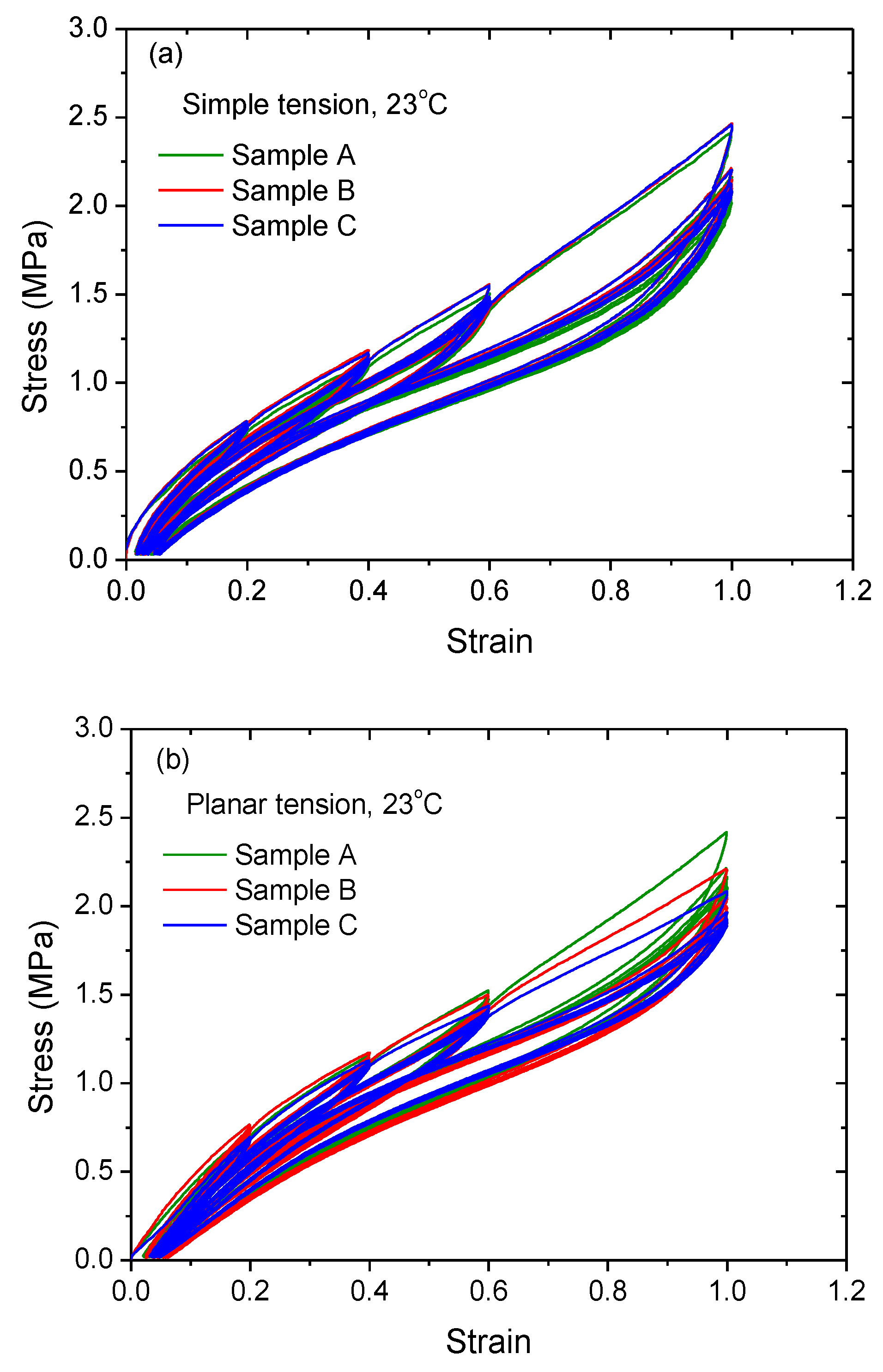




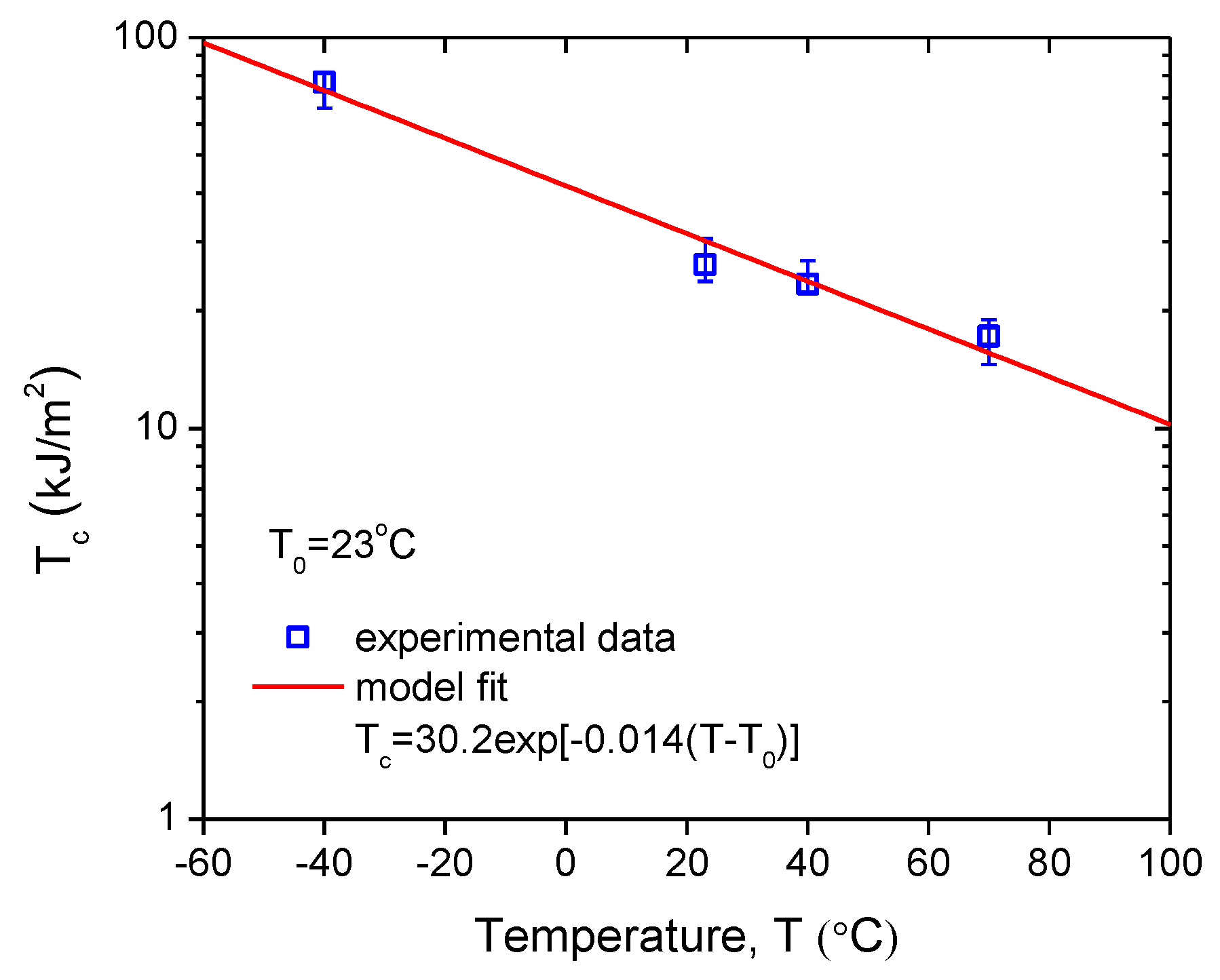



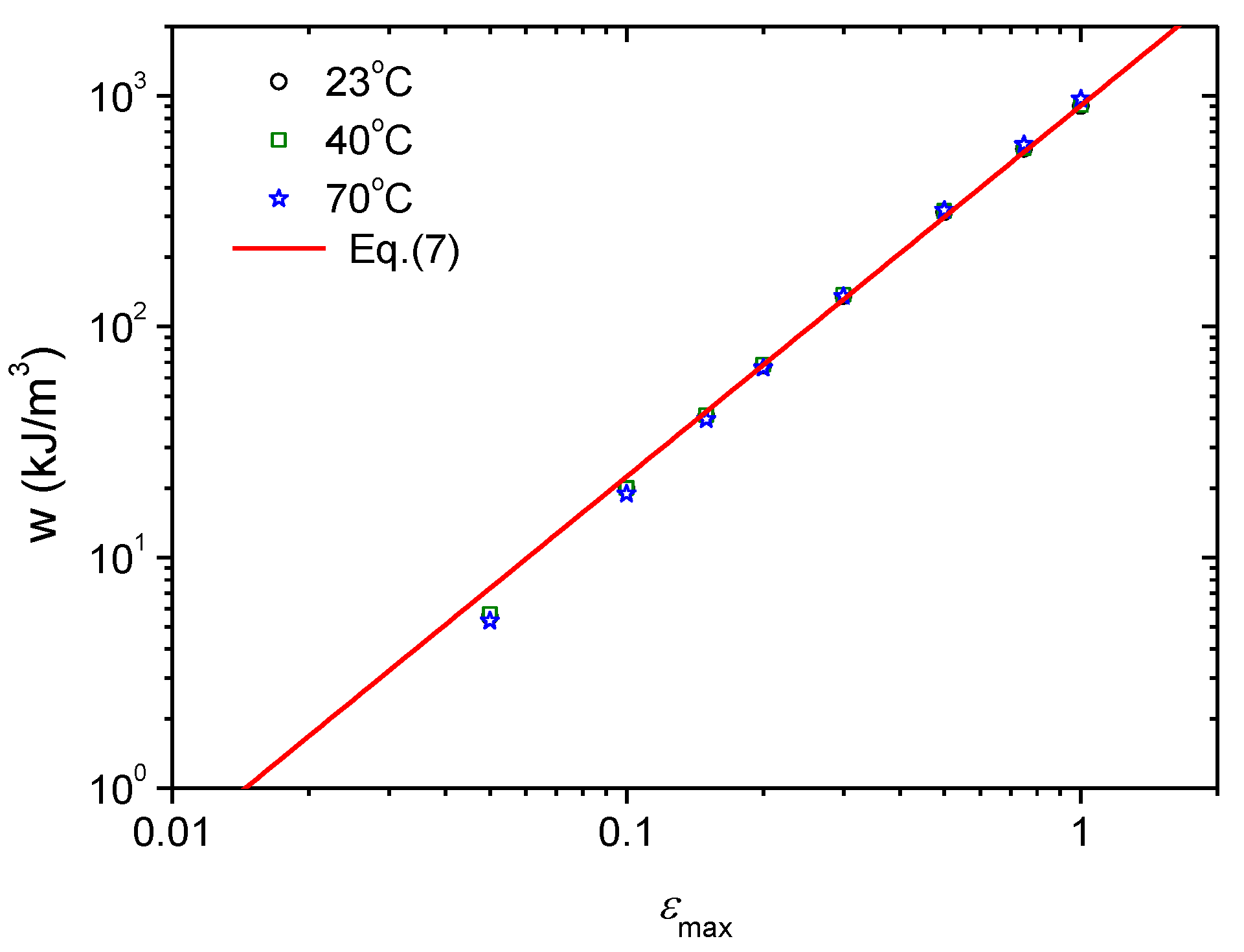

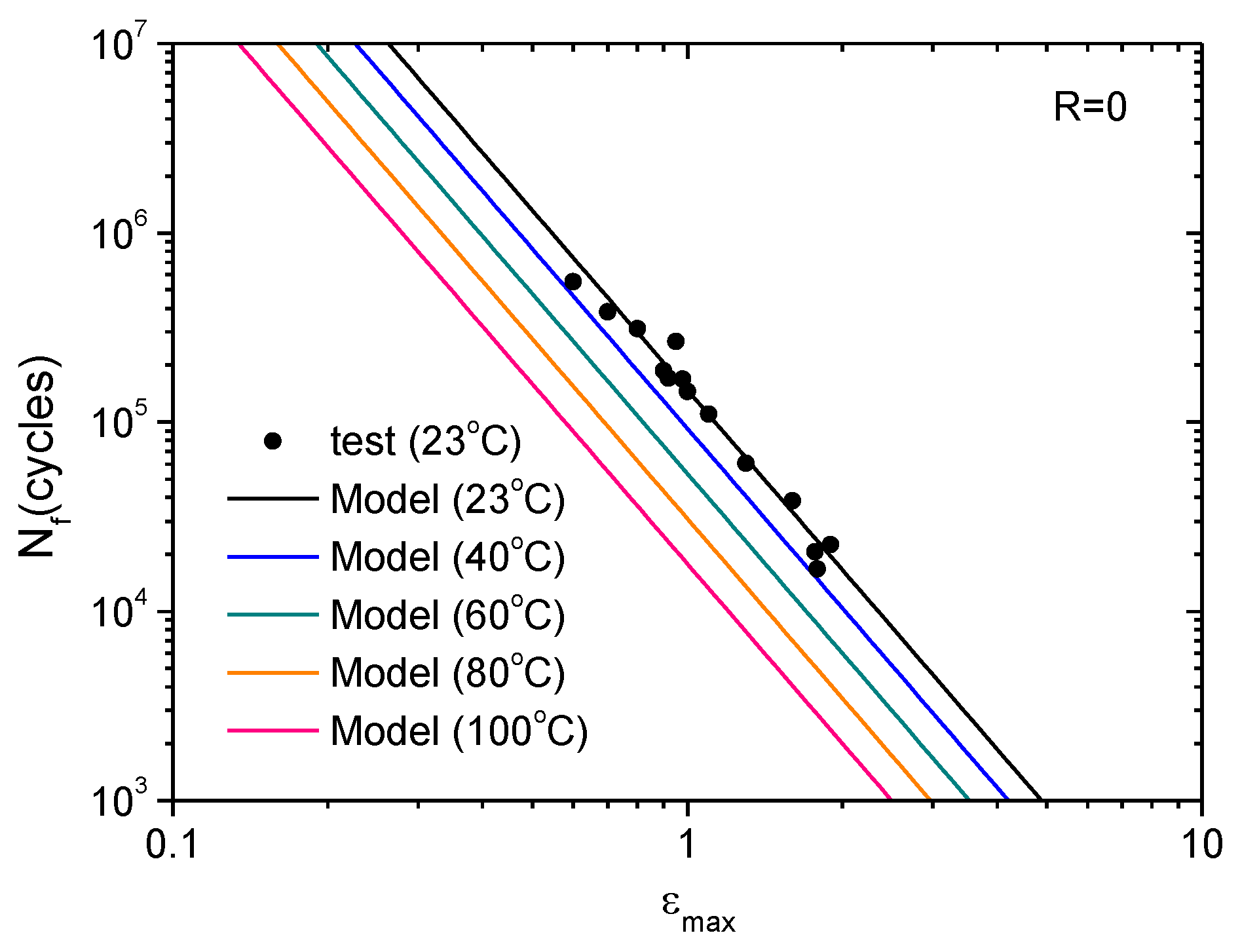
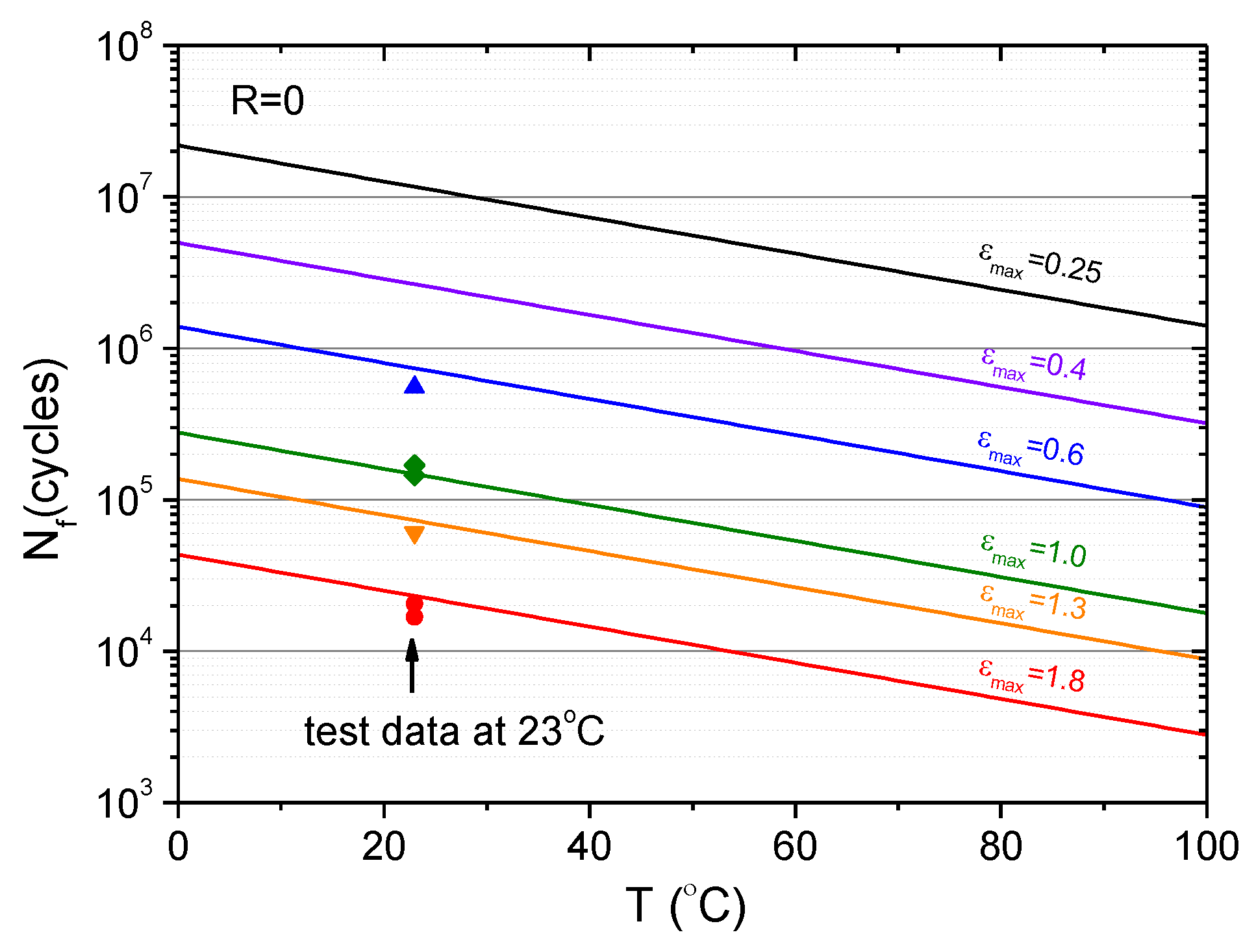
| Loading Stages | R | εmin | εmax | N/Cycles |
|---|---|---|---|---|
| 1 | 0 | 0 | 0.05~0.125 | 0~15,000 |
| 2 | 0 | 0 | 0.125 | 15,000~76,000 |
| 3 | 0~0.8 | 0~0.10 | 0.125 | 76,000~176,000 |
| 4 | 0 | 0 | 0.125~0.425 | 176,000~190,000 |
| 5 | 0 | 0 | 0.425 | 190,000~210,000 |
| 6 | 0~0.8 | 0~0.34 | 0.425 | 210,000~246,000 |
| 7 | 0 | 0 | 0.425~0.4625 | 246,000~248,000 |
| 8 | 0 | 0 | 0.4625 | 248,000~261,000 |
| 9 | 0~0.8 | 0~0.37 | 0.4625 | 261,000~282,500 |
© 2019 by the authors. Licensee MDPI, Basel, Switzerland. This article is an open access article distributed under the terms and conditions of the Creative Commons Attribution (CC BY) license (http://creativecommons.org/licenses/by/4.0/).
Share and Cite
Luo, W.; Li, M.; Huang, Y.; Yin, B.; Hu, X. Effect of Temperature on the Tear Fracture and Fatigue Life of Carbon-Black-Filled Rubber. Polymers 2019, 11, 768. https://doi.org/10.3390/polym11050768
Luo W, Li M, Huang Y, Yin B, Hu X. Effect of Temperature on the Tear Fracture and Fatigue Life of Carbon-Black-Filled Rubber. Polymers. 2019; 11(5):768. https://doi.org/10.3390/polym11050768
Chicago/Turabian StyleLuo, Wenbo, Ming Li, Youjian Huang, Boyuan Yin, and Xiaoling Hu. 2019. "Effect of Temperature on the Tear Fracture and Fatigue Life of Carbon-Black-Filled Rubber" Polymers 11, no. 5: 768. https://doi.org/10.3390/polym11050768






